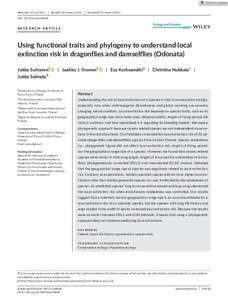Using functional traits and phylogeny to understand local extinction risk in dragonflies and damselflies (Odonata)
Suhonen Jukka; Ilvonen Jaakko J; Korkeamäki Esa; Nokkala Christina; Salmela Jukka
Using functional traits and phylogeny to understand local extinction risk in dragonflies and damselflies (Odonata)
Suhonen Jukka
Ilvonen Jaakko J
Korkeamäki Esa
Nokkala Christina
Salmela Jukka
WILEY
Julkaisun pysyvä osoite on:
https://urn.fi/URN:NBN:fi-fe2022081154032
https://urn.fi/URN:NBN:fi-fe2022081154032
Tiivistelmä
Understanding the risk of local extinction of a species is vital in conservation biology, especially now when anthropogenic disturbances and global warming are severely changing natural habitats. Local extinction risk depends on species traits, such as its geographical range size, fresh body mass, dispersal ability, length of flying period, life history variation, and how specialized it is regarding its breeding habitat. We used a phylogenetic approach because closely related species are not independent observations in the statistical tests. Our field data contained the local extinction risk of 31 odonate (dragonflies and damselflies) species from Central Finland. Species relatedness (i.e., phylogenetic signal) did not affect local extinction risk, length of flying period, nor the geographical range size of a species. However, we found that closely related species were similar in hind wing length, length of larval period, and habitat of larvae. Both phylogenetically corrected (PGLS) and uncorrected (GLM) analysis indicated that the geographical range size of species was negatively related to local extinction risk. Contrary to expectations, habitat specialist species did not have higher local extinction rates than habitat generalist species nor was it affected by the relatedness of species. As predicted, species' long larval period increased, and long wings decreased the local extinction risk when evolutionary relatedness was controlled. Our results suggest that a relatively narrow geographical range size is an accurate estimate for a local extinction risk of an odonate species, but the species with long life history and large habitat niche width of adults increased local extinction risk. Because the results were so similar between PGLS and GLM methods, it seems that using a phylogenetic approach does not improve predicting local extinctions.
Kokoelmat
- Rinnakkaistallenteet [27094]
